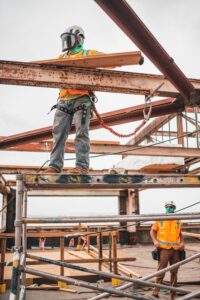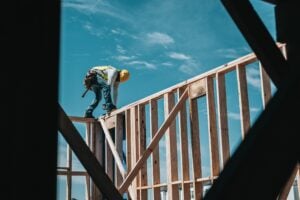Preconstruction and Safety
Safety and preconstruction. Those are two words that you probably don’t hear together very often. For the most part, when we think about safety, we’re usually thinking about it in terms of the jobsite. Is appropriate signage up, are people wearing hardhats, are they using ladders when they’re supposed to?
 Safety standards like hard hats and bright orange vests for visibility are relatively recent developments.
Safety standards like hard hats and bright orange vests for visibility are relatively recent developments.Preconstruction exists in a highly theoretical world of “what-ifs”—what happens to a project’s overall cost if this is tweaked or if that is added in. Safety, on the other hand, is much more practical and hands-on in comparison.
So it might surprise you to learn that safety standards and decisions actually have a lot of impact on preconstruction decisions, and vice versa. If your preconstruction team isn’t having regular conversations about safety expectations, you can end up with inaccurate bids and way too many change orders. But in order to understand why this transparency is so critical to a successful estimating effort, it’s important to get some context about current safety practices and the history and perceptions behind them.
Safety Is Often Seen As An Inconvenience, Not A Priority
Much like preconstruction, construction safety is an area of the industry that is frequently perceived as “just something we have to do” in order to get to the real accomplishment—finishing the project within budget. It’s not something that owners or general contractors typically want to spend a lot of time talking about. For many, they just want to be able to check off boxes on a list and be done with it.
This attitude toward safety has existed for centuries. As we observed in last year’s Construction Safety Week article, safety regulations on a nationwide level weren’t even introduced until the beginning of the 20th century, and Construction Safety Week itself has only been in existence since 2018. Certainly, some of this is just that the industry is notoriously slow to change. But a large part of it is also general contractors and owners seeing safety standards and practices as burdensome rather than enhancing value.
 People don't ignore safety standards because they don't think safety is important, but because it tends to be inconvenient.
People don't ignore safety standards because they don't think safety is important, but because it tends to be inconvenient.Why are safety requirements and methods—which save limbs and lives on a daily basis—so difficult for people to uphold? It’s not because safety isn’t important. It boils down to human nature. An article from Industrial Safety and Hygiene News points out that “safety is often a fight with human nature.” Inconvenience scores are almost always higher for safe behaviors as opposed to risky ones, because risky behavior usually presents in the form of a shortcut. “It’ll take too long to go get the taller ladder, I’ll just use this one even if it’s a little too short.” “I forgot my hardhat, but this will only take a second, I don’t need it.”
Obviously, not making safety a priority on the jobsite results in practical consequences like people getting injured or even dying, legal issues, and project delays. Not making safety a priority for consideration in the preconstruction phase can be equally as damaging.
What Happens When Safety Is Ignored During the Preconstruction Phase?
We sat down with Bill French, Director of Safety Services at CORE Safety, to get more insight as to how a lack of safety consideration during the preconstruction stage can negatively affect the entire project. He says: “There can be nuances on a project that are related to safety that are going to add to that material and labor cost. In some cases, yes, it’s an actual line item, but other times, you’re having to do a task a certain way because of a safety concern and it’s going to cost you more material, or more time, or more people.”
Just like on the jobsite, it can be tempting for both estimators and subcontractors to gun for the lowest possible number in order to win a bid, even if it might mean taking some shortcuts. What ends up happening? Yes, you very well might get the lowest number, but that’s usually because there are items you’re not factoring in. This can often boil down to a simple lack of transparency and communication. If you aren’t initiating discussions about safety expectations, your subcontractors may not bid appropriately, resulting in change orders and time wasted. As French observes, “The estimator needs to have that mindset of, 'Hey, okay, let’s run through the specifications—what are things that I might need to be aware of that aren’t just going to be a line item on the sheet?'”
Communication is especially critical because no two projects are the same when it comes to safety. French says, "Oftentimes owners can have varying degrees of safety expectations. Certain owners my have policies in place that are above and beyond the basic OSHA requirements." You can’t assume that subcontractors are going to bid with your safety standards in mind just because they’ve worked with you on a previous project—you have to talk to them, pre-bid, and make them aware of things like a Ladders Last program so they don’t accidentally underbid.
Safety Today and How Preconstruction Can Help
Thankfully, safety has come a long way from the 1920s, and even since 2018—and preconstruction can play a huge part in keeping safety a valued priority rather than an afterthought. Today, we know that safety training saves companies $4 to $6 for every $1 that they invest into safety programs, and that onsite injuries are down from 10.9 incidents per 100 workers in 1972 to 2.8 incidents per 100 in 2019.
Preconstruction can keep these statistics continuously improving by keeping safety at the forefront as they build out estimates and bring in subcontractor bids, and by making sure to keep communication about safety expectations constant and transparent.

-1.png?width=112&height=112&name=image%20(4)-1.png)














